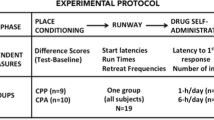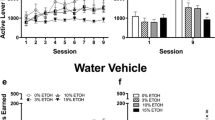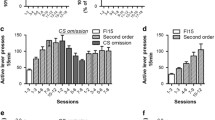Abstract
Rationale
Human drug users report that the initial positive effects of cocaine are followed by a dysphoric state characterized by anxiety and drug-craving. As a means of presumably attenuating these negative aftereffects, 50–90% of cocaine users choose to co-administer ethanol during cocaine binges. This co-administration reportedly prolongs the “high” and diminishes the “low” associated with cocaine use.
Objective
The current study was intended to assess whether this phenomenon could be modeled in the animal laboratory. We have previously shown that animals running a straight alley for an intravenous cocaine reward develop a unique approach-avoidance “conflict” behavior that is characterized by stop and retreat behaviors as the subjects approach the goal box. The retreats are thought to reflect the concurrent positive (reward) and negative (anxiety) associations with the goal box and can be dose-dependently reduced by pretreatment with diazepam, which presumably attenuates the anxiety stemming from the conflict.
Methods
To test the role of ethanol in reducing cocaine-induced anxiety, rats were trained to run a straight-arm alley for a single daily injection of cocaine (1.0 mg/kg IV).
Results
Rats that had the opportunity to then drink either an 8% or a 4% sucrose–ethanol solution immediately following their daily runway trial came to exhibit fewer retreats than rats that did not drink ethanol following their cocaine injection.
Conclusions
These results suggest that ethanol effectively reduces the development of approach-avoidance conflict in animals running an alley for IV cocaine, a result that may account for the prevalence of cocaine–ethanol co-administration in humans.





Similar content being viewed by others
References
Anthony JC, Warner LA, Kessler RC (1994) Comparative epidemiology of dependence on tobacco, alcohol, controlled substances, and inhalants: basic findings from the National Comorbidity Survey. Exp Clin Psychopharmacol 2:244–268
Aston-Jones S, Aston-Jones G, Koob GF (1984) Cocaine antagonizes anxiolytic effects of ethanol. Psychopharmacology 84:28–31
Borowski TB, Kokkinidis L (1994) Cocaine preexposure sensitizes conditioned fear in a potentiated acoustic startle paradigm. Pharmacol Biochem Behav 49:935–942
Brady KT, Sonne S, Randall CL, Adinoff B, Malcolm R (1995) Features of cocaine dependence with concurrent alcohol abuse. Drug Alcohol Depend 39:69–71
Brookoff D, Raotondo MF, Shaw LM (1996) Cocaethylene levels in patients who test positive for cocaine. Ann Emerg Med 27:316–320
Bunney EB, Appel SB, Brodie MS (2001) Electrophysiological effects of cocaethylene, cocaine, and ethanol on dopaminergic neurons of the ventral tegmental area. J Pharmacol Exp Ther 297:696–703
Carroll KM, Rounsaville BJ, Bryant BJ (1993) Alcoholism in treatment-seeking cocaine abusers: clinical and prognostic significance. J Stud Alcohol 54:199–208
Dean RA, Christian CD, Sample RHB, Borson WF (1991) Human liver cocaine esterases: ethanol-mediated formation of ethylcocaine. FASEB J 2736:2735–2739
Ettenberg A, Geist TD (1991) Animal model for investigating the anxiogenic effect of self-administered cocaine. Psychopharmacology 103:455–461
Ettenberg A, Geist TD (1993) Qualitative and quantitative differences in the operant runway behavior of rats working for cocaine and heroin reinforcement. Pharmacol Biochem Behav 44:191–198
Ettenberg A, Raven MA, Danluck DA, Necessary BD (1999) Evidence for opponent-process actions of intravenous cocaine. Pharmacol Biochem Behav 64:507–512
Farre M, de la Torre R, Llorente M, Lamas X, Ugena B, Segura J, Cami J (1993) Alcohol and cocaine interactions in humans. J Pharmacol Exp Ther 266:1364–1373
Geist TD, Ettenberg A (1990) A simple method for studying intravenous drug reinforcement in a runway. Pharmacol Biochem Behav 36:703–706
Geist TD, Ettenberg A (1997) Concurrent positive and negative goalbox events produce runway behaviors comparable to those of cocaine-reinforced rats. Pharmacol Biochem Behav 57:145–150
Grant BF, Harford TC (1990) Concurrent and simultaneous use of alcohol with cocaine: results of national survey. Drug Alcohol Depend 25:97–104
Griffiths RR, Bradford LD, Brady JV (1979) Progressive ratio and fixed ratio schedules of cocaine-maintained responding in baboons. Psychopharmacology 65:125–136
Higgins ST, Rush CR, Bickel WK, Hughes JR, Lynn M, Capeless MA (1993) Acute behavioral and cardiac effects of cocaine and alcohol combinations in humans. Psychopharmacology 111:285–294
Itzhak Y, Martin JL (1999) Effects of cocaine, nicotine, dizoipline and alcohol on mice locomotor activity: cocaine-alcohol cross-sensitization involves upregulation of striatal dopamine transporter binding sites. Brain Res 818:204–211
Jatlow P, Elsworth JD, Bradberry CW, Winger G, Taylor JR, Russel R, Roth RH (1991) Cocaethylene: a neuropharmocologically active metabolite associated with concurrent cocaine–ethanol ingestion. Life Sci 48:1787–1794
Knackstedt LA, Samimi MM, Ettenberg A (2002) Evidence for opponent-process actions of intravenous cocaine and cocaethylene. Pharmacol Biochem Behav 72:931–936
Koob GF, Caine SB, Parsons L, Markou A, Weiss F (1997) Opponent process model and psychostimulant addiction. Pharmacol Biochem Behav 57:513–521
LePen G, Duterte-Boucher D, Daoust M, Costentin J (1998) Pre-exposure to alcohol does not sensitize to the rewarding effects of cocaine. Neuroreport 9:2887–2891
Magura S, Rosenblum A (2000) Modulating effect of alcohol use on cocaine use. Addict Behav 25:117–122
Manley SJ, Little HJ (1997) Enhancement of amphetamine- and cocaine-induced locomotor activity after chronic ethanol administration. J Pharmacol Exp Ther 281:1330–1339
Margolin A, Avants SK, Kosten TR (1996) Abstinence symptomatology associated with cessation of chronic cocaine abuse among methadone-maintained patients. Am J Drug Alcohol Abuse 22:377–386
McCance-Katz EF, Price LH, McDougle CJ, Kosten TR, Black JE, Jatlow PI (1993) Concurrent cocaine–ethanol ingestion in humans: pharmacology, physiology, behavior, and the role of cocaethylene. Psychopharmacology 111:39–46
McCance-Katz EF, Kosten TR, Jatlow PI (1998) Concurrent use of cocaine and alcohol is more potent and potentially more toxic than use of either alone. A multiple-dose study. Biol Psychiatry 44:250–259
Miller NE (1944) Experimental studies of conflict. In: Hunt IMcV (ed) Personality and the behavior disorders. Ronald, New York, pp 431–465
Nomikos GG, Spyraki C (1988) Cocaine-induced place conditioning: importance of route of administration and other procedural variables. Psychopharmacology 94:119–125
Pan W-J, Hedaya MA (1999) Cocaine and alcohol interactions in the rat: contribution of cocaine metabolites to the pharmacological effects. J Pharm Sci 88:468–476
Pickens R, Thompson R (1968) Cocaine-reinforced behavior in rats: effects of reinforcement magnitude and fixed-ratio size. J Pharmacol Exp Ther 161:122–129
Raven MA, Necessary BD, Danluck DA, Ettenberg A (2000) Comparison of the reinforcing and anxiogenic effects of intravenous cocaine and cocaethylene. Exp Clin Psychopharmacol 8:117–124
Rogerio R, Takahashi RN (1992) Anxiogenic properties of cocaine in the rat evaluated with the elevated plus-maze. Pharmacol Biochem Behav 43:631–633
Rounsaville BJ Anton SF, Carroll K, Budde D, Prusoff BA, Gawin F (1991) Psychiatric diagnoses of treatment-seeking cocaine abusers. Arch Gen Psychiatry 48:43–51
Simon P, Dupuis R, Costentin J (1994) Thigmotaxis as an index of anxiety in mice: influence of dopaminergic transmissions. Behav Brain Res 61:59–64
Smith DE (1986) Cocaine–alcohol abuse: epidemiological, diagnostic and treatment considerations. J Psychoact Drugs 18:117–129
Solomon RL (1980) The opponent-process theory of acquired motivation: the costs of pleasure and the benefits of pain. Am Psychol 35:691–712
Solomon RL, Corbit JD (1974) An opponent-process theory of motivation. I. Temporal dynamics of affect. Psychol Rev 81:119–145
Spanagel R, Weiss F (1999) The dopamine hypothesis of reward: past and current status. Trends Neurosci 22:521–527
Spyraki C, Nomikos GG, Varonons DD (1987) Intravenous cocaine-induced place preference: attenuation by haloperidol. Behav Brain Res 26:57–62
Weiss RD, Mirin SM, Griffine ML, Michael JL (1988) Psychopathology in cocaine abusers: changing trends. J Nerv Ment Dis 176:719–725
Williamson S, Gossop M, Powis B, Griffiths P, Fountain J, Strang J (1997) Adverse effects of stimulant drugs in a community sample of drug users. Drug Alcohol Depend 44:87–94
Willick ML, Kokkinidis L (1995) Cocaine enhances the expression of fear-potentiated startle: evaluation of state-dependent extinction and the shock-sensitization of acoustic startle. Behav Neurosci 102:929–939
Yang X-M, Gorman AL, Dunn AJ, Goeders NE (1992) Anxiogenic effects of acute and chronic cocaine administration: neurochemical and behavioral studies. Pharmacol Biochem Behav 41:643–650
Acknowledgements
The authors thank Maggie Hogan, Max Samimi, Genevieve Bender, Michele Bongiovanni and Michael Thurman, who assisted with the running of the subjects. Special thanks to Rick Bernardi for technical assistance. The research described herein was supported by funds from the National Institute of Drug Abuse grant DA05041 awarded to A.E.
Author information
Authors and Affiliations
Corresponding author
Rights and permissions
About this article
Cite this article
Knackstedt, L.A., Ettenberg, A. Ethanol consumption reduces the adverse consequences of self-administered intravenous cocaine in rats. Psychopharmacology 178, 143–150 (2005). https://doi.org/10.1007/s00213-004-1996-2
Received:
Accepted:
Published:
Issue Date:
DOI: https://doi.org/10.1007/s00213-004-1996-2




